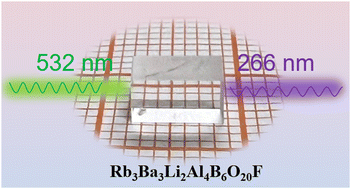A promising ultraviolet nonlinear optical crystal: Rb3Ba3Li2Al4B6O20F—crystal growth, physical properties, and 266 nm laser generation†
Abstract
Ultraviolet laser is an indispensable technology applied in the fields of photolithography, micromachining, and laser prototyping. To date, only β-BaB2O4 and CsLiB6O10 are commercially available for direct fourth harmonic generation (266 nm) output of a fundamental wavelength (1064 nm). However, they suffer from the drawbacks of large walk-off angles or highly hygroscopic nature, respectively. Herein, the crystal growth, physical properties, and 266 nm laser generation of Rb3Ba3Li2Al4B6O20F (RBLABF) were systematically evaluated. The results indicate that RBLABF can be grown as high-quality and large-size single crystals. Also, it exhibits excellent comprehensive performances, i.e., non-deliquescence, moderate birefringence (0.06@532 nm), short phase-matching wavelength (262 nm), large NLO coefficient (0.46 pm V−1), small walk-off angle (0.74°@532 nm) and large acceptance angle (10.56 mrad mm@532 nm), small anisotropic thermal expansion, and desirable specific heat and thermal conductivity. More importantly, the 266 nm laser was successfully output through an RBLABF crystal device. These make RBLABF a competitive UV NLO crystal for 266 nm laser generation.

- This article is part of the themed collection: Journal of Materials Chemistry C HOT Papers


 Please wait while we load your content...
Please wait while we load your content...